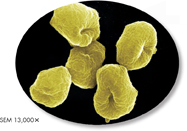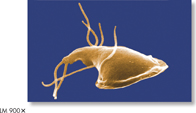
FIGURE 18–16 Sulfolobus This member of the domain Archaea is found in hot springs and thrives in acidic and sulfur-rich environments.
Domain Archaea Also unicellular and prokaryotic, mem-bers of the domain Archaea (ahr KEE uh) live in some of the most extreme environments you can imagine—in volcanic hot springs, brine pools, and black organic mud totally devoid of oxygen. Indeed, many of these bacteria can survive only in the absence of oxygen. Their cell walls lack peptidoglycan, and their cell membranes contain unusual lipids that are not found in any other organism. The domain Archaea corresponds to the kingdom Archaebacteria.
Domain Eukarya The domain Eukarya consists of all organisms that have a nucleus. It comprises the four remaining major groups of the six-kingdom system: “Protista,” Fungi, Plantae, and Animalia.

FIGURE 18–17 ”Protists” ”Protists” can live just about anywhere. Giardia is a parasitic freshwater ciliate.
▸ The “Protists”: Unicellular Eukaryotes Recall that we are using quotations with this group to indicate that it is a paraphyletic group. Although some people still use the name “protists” to refer to these organisms, scientists who work with them have known for years that they do not form a valid clade. Figure 18–18 reflects current cladistic analysis, which divides these organisms into at least five clades. The positions of these groups on the cladogram reflect its paraphyletic nature.
Table of Contents
- Formulas and Equations
- Applying Formulas and Equations
- Mean, Median, and Mode
- Estimation
- Using Measurements in Calculations
- Effects of Measurement Errors
- Accuracy
- Precision
- Comparing Accuracy and Precision
- Significant Figures
- Calculating With Significant Figures
- Scientific Notation
- Calculating With Scientific Notation
- Dimensional Analysis
- Applying Dimensional Analysis




